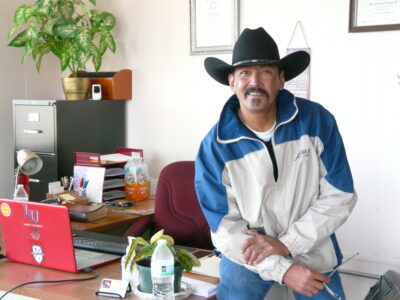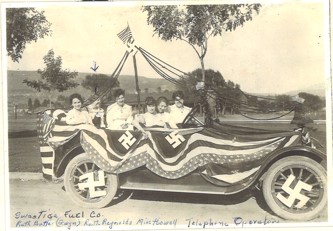Raton’s Kearny Entrada: A History Lesson Packed with Fun
By Pat Veltri
Saturday, May 27, 1954…It was a beautiful Spring day, bright and crisp. Hear Ye! Hear Ye! The call of the bailiff reverberated in the air, summoning Ratonians to the first session of the Kearny Entrada Kangaroo Court. Ladies and young girls flounced the skirts of their squaw dresses, creating a feminine swishing sound, as they sauntered towards Cook Avenue, where crowds of onlookers were milling about on the lawn of the Raton Post Office, in anticipation of the Court’s opening session. Mack Urioste, Raton’s Postmaster, in his role as Donaciano Vigil, New Mexico Territorial Governor, stood before the crowd, sartorially resplendent in a black uniform trimmed in white braid, with a colorful serape draped over his right shoulder. A tall-crowned, broad-brimmed black sombrero, fancied up with an image of the Spanish Imperial Eagle, completed his impressive ensemble.
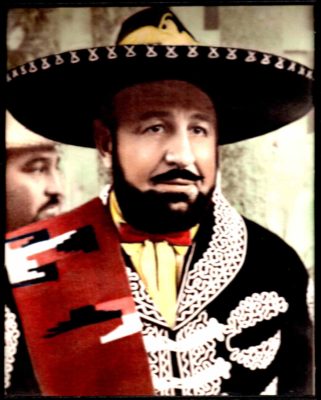
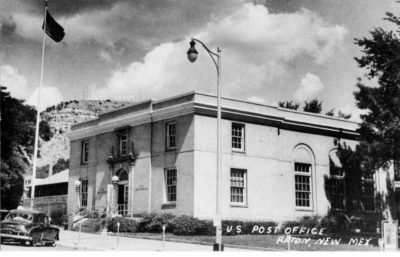
Governor Vigil, alias Urioste, acting as “Judge” of the Kangaroo Court, instructed U.S. Entrada Marshal R.J. Bonahoom, otherwise known as Raton Police Chief, Dick Bonahoom, to serve subpoenas to six questionable malefactors purported to have violated Kearny Entrada laws. The six malefactors, and their crimes, included: Gene Moore – accused of trying to overthrow parking meters by force and violence; Jack Horner – seeking to leave the jurisdiction of the Entrada court without permission; William Darden – contempt of court by refusing to grow a beard on the grounds of the 18th Amendment; W.W. Lang – unlawful entry into the territory of New Mexico from Oklahoma; Bob Hoke – fishing out all the streams in the territory of New Mexico; and Willet Majors – for not wearing an Entrada tie (misdemeanor).
Governor Vigil, aka Urioste, explained in The Raton Daily Range, that the penalty for the various crimes charged in the indictments was “somewhat fluid”. The punishment of choice was a medieval type of dunking contraption set up on the post office lawn. “We’re not throwing books at anybody, he said, but we might very well throw them in the tank,” he added. “But anybody who thinks we’re fooling,” he went on ominously, “is gonna be all wet!”
Turnabout is fair play! The “Judge” meted out dunkings and other assorted penalties with unbridled enthusiasm, but apparently at one of the final court sessions, played out on Park Avenue, three malcontents decided things had gone too far and decided to give Urioste a taste of his own medicine. His punishment was “somewhat fluid”. No fooling, the “Judge” was thrown in the tank! He was all wet! Naturally, The Range couldn’t pass up the opportunity to capture the moment on film and the resulting image portrayed Urioste’s waving foot sticking up out of the tank, the only part of him that stayed dry!
The above bit of nonsense culled from the archives of The Raton Daily Range, heralded the beginning of festivities for the first annual Kearny Entrada to be held in June 1954. Readers may be pondering the question: what is a Kearny Entrada? Simply put, it was a two-day historical celebration tempered with loads of fun. The Range archives didn’t precisely delineate who was responsible for dreaming up the idea of the Entrada, but plans began falling into place, starting in January 1954.
The History Lesson
The historical part of the celebration, in the form of a pageant, commemorated the conquest of New Mexico by U. S. Army General Stephen Watts Kearny during the Mexican-American War. The following paragraphs, based on information from the Center for Greater Southwestern Studies, outline the story of Kearny’s dramatic march over Raton Pass and entrance (entrada) into New Mexico where he ultimately accomplished a successful conquest without the loss of a single life.
The beginning of the war found Kearny at Fort Leavenworth, Kansas where in May 1846, under orders from U.S. President James K. Polk, he began assembling troops “charged with” conquering New Mexico and California. Numbering about 1600 men, Kearny’s forces, known as the Army of the West, left Fort Leavenworth in June 1846.
On July 22 Kearny’s army reached Bent’s Fort in Colorado. Soon afterward Kearny sent word to New Mexico Governor, Manuel Armijo, that the Americans planned to take “possession” of New Mexico. He used diplomacy rather than force and marched unopposed into Santa Fe in August 1846. Armijo had beaten a hasty retreat to Chihuahua, Mexico rather than engage in battle.
Kearny installed Charles Bent, an American trader, as territorial governor and established a legal code for New Mexico, promising to respect New Mexican property and religion. Four months into Bent’s administration, U.S. troops withdrew from New Mexico. Heading for California with his Army of the West, Kearny assigned Colonel Alexander Doniphan and a small group of Missouri volunteers to hold Santa Fe and Taos.
During the Taos Revolt of 1847 Bent was scalped and killed by Pueblo Indian attackers, under the orders of Mexican conspirators. Subsequently, the office of territorial governor was assumed by Donaciano Vigil, Bent’s secretary and chief advisor.
A point to remember is that Raton, the town, did not actually exist during the time of Kearny’s entrance into New Mexico, but it’s a safe bet that his troops probably rested on the site of present-day Raton after their arduous hike over the Pass.
Getting Started
While Raton’s city fathers were treading on uncharted waters in deciding to stage the elaborate Kearny Entrada, they wisely sought input, advice, and assistance from other communities, as well as a couple of state agencies, ultimately leading them to rack up a successful celebration.
By February 1954, as noted in The Range, the Kearny Entrada committee had set June 17- 18 as the dates for the historical festival. Advance publicity and advertising support had been promised to the Kearny Entrada by the director of the New Mexico Tourist Bureau, and officials from Raton’s La Mesa Park. The horse racing park had offered to devote several pages of its annual racing catalog to the Entrada. The public relations department of Highlands University also promised to help promote the event.
In addition, the State Tourist Bureau volunteered to help stage the initial Entrada, including the preparation of the script for the reenactment of the conquest of New Mexico by Stephen Watts Kearny. The Fine Arts Director of the New Mexico Museum in Santa Fe offered a number of recommendations for showcasing the Indian, Spanish, and Anglo cultures that were brought together by Kearny’s triumph over Mexico.
At a February 15th meeting, the Entrada Committee elected officers and submitted incorporation papers for the event, which were filed with state offices in Santa Fe. The filing date for Kearny Entrada, Inc., a domestic nonprofit corporation, was March 19, 1954. Just as an aside, sixty-eight years later, the company is still listed in the New Mexico Corporations Division, with a filing status of Existence Expired.
Settling the Money Problem
A campaign for funds to cover the cost of financing the first annual Entrada was thoroughly discussed by the Entrada committee at their April 1954 meeting. A maximum budget of $3000 for expenses was set “ ‘with every effort being made to hold the total considerably below that figure”, according to The Range. Entrada Committee members voted that any expense item be approved by the finance subcommittee. To assure financial solvency for the first time Entrada event, The Range reported that the finance subcommittee had been working on “securing pledges from local business and professional men to underwrite the cost”. The Range further stated that the Entrada Committee members “were highly optimistic in their belief that the event will be largely ‘self-financing’ with such events as dances and barbeque dinners actually adding income rather than an expense to the budget”.
On April 15, 1954, one thousand lapel buttons advertising the Kearny Entrada went on sale in Raton. Selling for a buck apiece, the buttons were another way of garnering funds to cover expenses. Additionally, “shaving permit” ties were sold to the male portion of Raton’s population, exempting the buyers from growing beards for the event.
Raton’s mayor, Floyd Atchison, became invested in the venture by issuing an official proclamation intended to suffuse the local public with the Kearny Entrada and also bring it to the attention of the remote public. The proclamation, signed on April 20, 1954, officially declared the time starting from April 20 and lasting until and including June 18, 1954, to be known as “The Entrada Period” and “called upon the Raton Citizenry to cooperate with the officers and committeemen of the Kearny Entrada, especially in the manner of dress suggested in this proclamation”. The male population of Raton and Colfax County was urged to participate in the “growing of hirsute adornment on the lower mandibles”; in other words, it was strongly recommended that they raise a beard. Atchison made a plea in his proclamation to all citizens, male and female, to wear western garb reminiscent of the 1846-ish days when General Stephen Watts Kearny and his Army of the West trekked over Raton Pass to conquer New Mexico for the United States. Citizens who dared to ignore the mayor’s proclamation paid some sort of penalty handed out by a Kangaroo Court.

Newspaper photo from The Raton Daily Range archives, circa 1954
As the month of May approached beards, buttons, ties, squaw dresses, and western attire, became the “usual” and the “typical”. The air was charged with excitement as citizens went about their business decked out in 1846-era finery. The men folk packed away their shaving gear, sprouting beards that ranged from scraggly to neat to shaped to bushy to curly. Ratonians were stoked to the max as they anticipated the upcoming celebration!
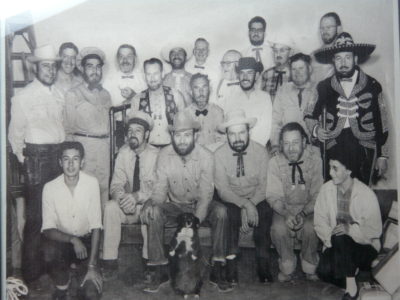
Pre-Entrada Doings
Leading into the actual fiesta set for June 17 and 18, 1954 were several pre-Entrada activities, all contributing to the festive air. In addition to the beard-growing contest and several Kangaroo Court sessions, seven pre-Entrada dances were held. Attendees cut the rug to the tunes of Squeeze Ruiz’s Orchestra, Frisco Canyon Ramblers, and other local bands. At the fourth dance Rose Marie Cordova was chosen as the Ambassadress of Good Will to the Kearny Entrada. The Reina Hermosa (Beautiful Queen) was crowned by none other than Mack Urioste, “Judge” of the Kangaroo Court.
Plans for the gala two-day celebration were finalized at a key meeting of the Kearny Entrada Committee on May 19th at the Hotel Yucca. Envisaging the Entrada to be a spectacular regional event – the bigger the better – Committee President Bob Perry had invited all persons in Raton and other northeastern New Mexico communities interested in the Entrada to attend this most important meeting to set their communities’ plans. Springer, Maxwell, Taos, Cimarron, Roy, and Mosquero responded enthusiastically to the request to participate in the Entrada, specifically in the parade.
A final push for publicity resulted in the scheduling of three advertising tours, also during the month of May. The first tour, comprised of a team of Raton’s citizens, along with a band and several costumed Entrada characters, stopped off in Maxwell, Springer, Roy, and Mosquero, staging a short program in each community and distributing Entrada advertising materials. The second tour took in Trinidad, Colorado, and Clayton, New Mexico, while the final tour included Cimarron, Eagle Nest, and Taos.
Day One
And then the big day came…. Thursday, June 17, 1954. Welcome signs were up, as well as two large Entrada signs posted at the north and south entrances to the city. Copies of the special Entrada Edition of The Raton Daily Range had been distributed to all motels, hotels and restaurants. Crowds of tourists had arrived in the city, filling motels and hotels to capacity.
The first annual Kearny Entrada celebration officially opened with an Old Timer’s picnic at the Raton Community Center. Scores of pioneers from northeastern New Mexico enjoyed spinning tales from the good old days and kibitzing with friends. Included among the guests was eighty-nine-year-old Annie Kearny Bragg of Pueblo, Colorado, a granddaughter of General Stephen Watts Kearny.
By 2:00 crowds were lining Second Street in anticipation of the Children’s Parade. Hundreds of costumed youngsters from Raton and surrounding communities put on a show for their parents, and other onlookers, with their Radio Flyers morphed into “covered wagons”, their colorfully embellished bicycles, or for those lucky enough to have a pony, strutting their stuff on horseback.
Late in the afternoon a historic sham battle, sort of an adult version of “Texans and Indians”, was held south of La Mesa Park race track, followed by a king-sized barbeque – open to everyone – held at the Park’s grandstand. The final event of the day was a gala square dance at the high school auditorium with the Pancho Baird Orchestra playing the tunes. Marvin Shilling was the caller: “Ladies in, men sashay. Roll away to a half sashay…”
Grand Finale
The final day of the Kearny Entrada kickstarted with a spectacular thirty-five-block, two-hour parade, along Second Street, boasting sixty entries. Watching the parade from a viewing stand in front of the Elks Lodge, were several VIPs, notably the Governor of New Mexico, Edwin Mechem, and gubernatorial candidates Alvin Stockton of Raton and John Simms of Albuquerque. Photos in The Raton Daily Range newspaper archives depicted thousands of people, lining both sides of Second Street, turning out to watch the parade. According to a report in The Range, “Costumes of the Entrada period festooned not only the paraders but were the rule among the thousands of watchers lined up for twelve blocks along Raton’s main traffic artery”.
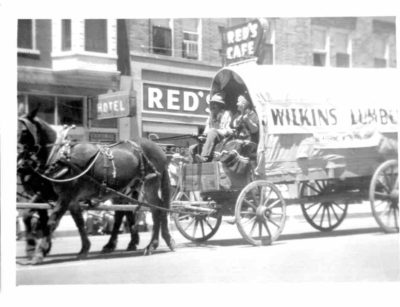
Kearny Entrada parade entry from Wilkins Lumber Co. (Photo from Veltri Collection)
Afternoon entertainment included a Gymkhana (competitive games on horseback) at La Mesa Park and the Kearny Entrada Pageant, a tableau of the takeover of New Mexico by General Stephen Watts Kearny during the Mexican-American War, presented during the Gymkhana intermission.
The Kearny Entrada Dance, featuring continuous music by two local musical groups, the Squeeze Ruiz Orchestra, and the Frisco Canyon Ramblers, plus a jazzy floor show, brought the immensely successful Entrada to a close.
A banner headline on the front page of the June 19th edition of The Raton Daily Range declared the Kearny Entrada a big success! It turns out that financing the celebration was no worry. The Range stated, “Entrada officials announced that the gala event had paid for itself and that, although no final accounting has been made yet, those who subscribed to underwrite the Entrada financially would not have to be asked for funds to help pay off expenses”. The closing balance sheet did, in fact, reveal that “over $1K was netted as profit in the venture”. The financial gain would act as a “starter fund” to enable Entrada officials to prepare for the next year’s fete.
Kearny Entrada: The Rest of the Story
With the first successful Kearny Entrada under their belts, the 1954 committee was in full agreement that the event should be repeated annually, “with extra effort to make each new celebration ‘bigger and better” as stated in The Raton Daily Range. The popular celebration continued for a few more years, with the stopping point in the year 1957.
The Kearny Entrada took on a new moniker in 1957. In an April committee meeting action was taken to call the event the Kentrada. A report in The Range on April 5 stated, “The move was made to provide a more original name for the annual event”.
Added to the Kentrada schedule was a three-performance rodeo, with L.D. Ward of Trinidad, Colorado as producer. During May Raton literally exploded with western wear as the “Go Western” movement began. Kentrada backers expected everyone to don some western duds, turning all of the “drugstore cowboys” into walking advertisements for the Kentrada and the rodeo that was planned as the big attraction for 1957. Bow ties printed with Raton Kentrada, June 6-8, 1957 were being sold in the business district. Coupled with the spiffy western togs, the ties were a surefire way to nail down visitor awareness of the Kentrada celebration.
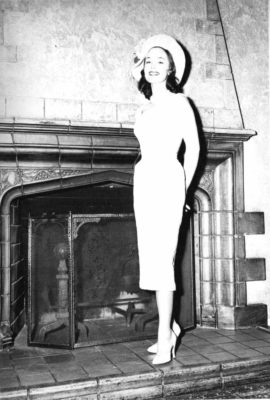
Glamorous movie and television star Dorothy Hart, posing in the Hotel Yucca, circa 1957 (Photo from the Veltri Collection)
The icing on the cake was the scoring of TV and movie actress Dorothy Hart as the guest of honor for the 1957 Kentrada festivities. In 1951, Hart, one of the stars of the movie Raton Pass, turned out for the movie’s world premiere in Raton, along with a couple of her co-stars, Dennis Morgan and Steve Cochran. During her appearance in Raton, in connection with the movie premiere, Hart became acquainted with several Ratonians, particularly Miss Evlyn Shuler. The end result of an exchange of letters between the actress and the town’s librarian was Hart’s return to Raton for the Kentrada experience.
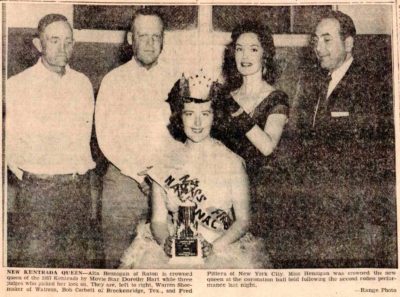
Newspaper photo from The Raton Daily Range archives, circa 1957
Hart, accompanied by her husband Fred Pittera, participated in most of the Kentrada activities, including appearances in the parade, the dances, and all performances of the rodeo. At a glitzy coronation ball, following the second rodeo performance, Hart officially installed Miss Alta Hennigan as the queen of the 1957 Kentrada. Lastly, Hart was honored at La Mesa horse racing park on the final day of Kentrada action, when the featured race, the Dorothy Hart Handicap, was run as a tribute to her.
Raton’s Kentrada celebration, observing the story of General Stephen Watts Kearny’s conquest of New Mexico, gently faded into the past following the conclusion of the 1957 festivities. By all accounts, the final Kentrada, running the gamut from the usual pageant, parade, barbeques, and dances to a rip-roaring rodeo and rodeo queen contest, was a megahit, a real success as an event. Why then did the Kentrada come to an inauspicious end? A study of The Raton Daily Range archives clearly indicates that the Kentrada coffers were not exactly in the chips. Hints of possible financial troubles were dropped here and there in The Range’s daily accounts of the celebration. Harley Williams, manager of Newberry’s, and general chairman of the celebration pointed out in a Range article dated June 8th, that the 1957 Kentrada would “go in the hole financially” unless at least 3000 persons turned out for the third rodeo performance. The rodeo had been planned as the financial backbone of the entire celebration but attendance was wanting at the first two performances. Williams later guesstimated that “the Kentrada revenue fell short of expenses”, but he was optimistic that upcoming post-Kentrada dances might raise funds to make the event break even.
The final accounting of finances, however, showed a mere sixty-seven dollars in the Kentrada bank account, with outstanding bills totaling several hundred dollars. A small group of business firms underwrote some of the events, but the money collected was not enough to take care of the debts. Apparently, after the initial profit in 1954, the Kentrada fund had fallen into arrears.
Preparation by dozens of individuals. Hundreds of man hours planning a multitude of activities – rodeo, parade, pageant, dances, barbeques, horse races. Numerous trips to surrounding communities to tout the function. Every year from 1954 to 1957 an exceptionally organized team of dedicated, hard-working Ratonians was elected to plan and produce the spectacular Kentrada extravaganza. The rallying cry of the team members was “bigger and better every year”– they thought big and the resulting celebration was big! Regrettably, even though the team members could well be proud of what they did, the budget had begun falling in the red as early as the second year of the Kentrada’s existence. Perhaps those in charge decided that the right thing to do was discontinue the event rather than seek other ways to finance the ambitious project.
Remembering the Little Things
Some sixty-eight years have passed since the first Kearny Entrada but many Ratonians still have sentimental recollections of the special event. Several townspeople were willing to take a walk down memory lane and share their cherishable memories of the past:
Betty J. Bowers
- “I don’t remember a lot of the actual parade through Raton but I do remember it was a “big deal” to my parents. I was fortunate enough to have been raised in the best of both worlds. My mother’s family lived in Raton so we lived there during school months when my brother and I could attend school. In the summer we moved to our family ranch twenty miles east of Maxwell. The ranch belonged to my father’s family and I loved the time spent there. When the Kearny Entrada came it was during the summer and a very festive time. Friends and neighbors were all excited about it and the grown-ups talked about it often. It was such a grand time that my mother had special matching dresses made for her and me. They were squaw style and bright turquoise with contrasting trim. Seems like the trim was yellow and red. I don’t recall who made the dresses. My mother didn’t sew so I am sure they were made by someone else. My father and I were always excited to see the big horses pulling wagons. I remember talking of the “Budweiser Clydesdales” but I am not sure if it was actually them or just large draft horses in the parade. I do recall being very unhappy having to put on the beautiful squaw dress, take off my jeans, and give up riding my Shetland pony, Dawn. I was such a tomboy and loved spending time riding horses with my brother all over the ranch. The photo is actually taken of my mother, my horse Dawn, and me at our ranch before leaving for the Kearny Entrada. My mother’s father, Dr. Cary Elliott had his office in the old DiLisio building, on the second floor above the clothing store. His windows looked out on Second Street so we always had a perfect place to watch the parades and enjoyed a great view. I remember it being a long parade with lots of horses, bands, lots of people, and a very festive atmosphere.”
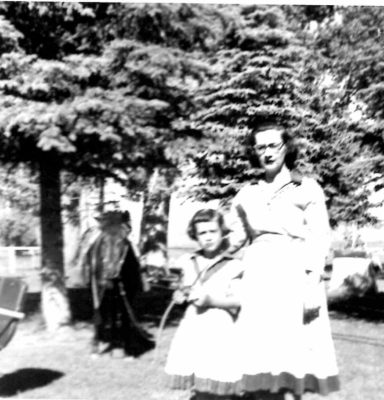
Betty Bowers as a child with her mother and her horse Dawn (Photo is courtesy of Betty Bowers)
- Janet Wingo
- “I don’t remember a lot about the Kearny Entrada. There was a big parade and a rodeo. Many of the local businessmen grew beards and the women wore squaw dresses. My mother, Marie Komora, made my friend Karen Sultemeier and my turquoise and white squaw dresses with rows and rows of colored rick racks on them. The Kearny Entrada was a celebration of the whole town and everyone enjoyed it!”
Diana Bonahoom Best and Barbara Bonahoom
- “We remember the colorful squaw dresses the women and girls wore, the various sizes and shapes of the beards the men wore, and the large number of people who were in downtown Raton for the festivities and the parade.Our father, Chief of Police Richard Bonahoom, was the town marshal for the Entrada. He was to arrest any man who failed to grow a beard or mustache; they were placed in a specially constructed prison stockade, then appeared before Kangaroo Court Judge Mack Urioste.”Many of the women made their own squaw dresses. They were colorful, full-skirted, and most wore a concho belt around their waist.The Kearny Entrada parade was so exciting. There were plenty of cowboys, cowgirls, several bands from around the area, the XIT Rangers from Dalhart, floats, and the parade was several blocks long.
Pie-eating contests, cake walks, beard contests, plus many other activities were held. The street dances were held at night time.”
Ellen Urioste Haines
- “My dad, Mack Urioste, was the postmaster. He played the role of Governor Donaciano Vigil and was the Judge of the Kangaroo Court. He enjoyed doing the role. He had a strong conviction that he wanted to do it. No one asked him if he wanted to play the part. During the Kangaroo Court, any man who didn’t have a beard could get dunked in the big barrel of water. Someone would pitch a ball to try to hit the dunking mechanism to release the seat of the dunkee. All of Raton would be there to watch. It was the highlight of the festivities. My dad encouraged all of the postal workers to grow beards and they did. I think they enjoyed all of it as well.My grandmother, Juanita Fernandez, was a weaver. She made beautiful blankets and was very proud of her craft. I still have a couple of her blankets. I remember that she rode on a float in the parade. Her loom was on the float and she sat there like she was actually weaving. Grandma was in her eighties at the time. She was dressed in her squaw dress and a pioneer bonnet.”
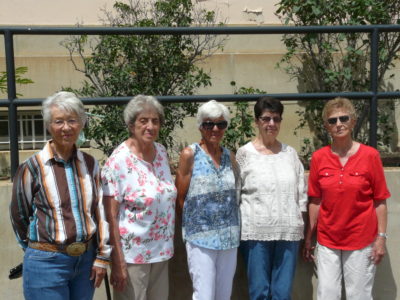
Left to right: Betty Bowers, Diana Best, Barbara Bonahoom, Ellen Haines, and Janet Wingo on the site of the first Kearny Entrada Kangaroo Court session, the former Raton Post Office lawn
- *Note to Readers: If you have a Kearny Entrada memory, please share it in the “Comments” section below. Thanks! Pat


